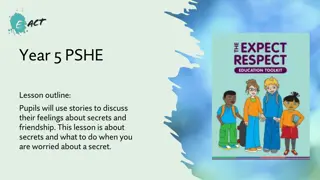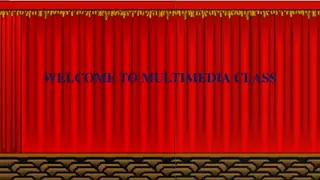
Exploring Mood and Atmosphere Through Writers' Presentation
This discussion delves into the concept of dramatic irony in literature, specifically focusing on how the audience's knowledge surpasses that of the characters. The exploration extends to analyzing how characters' behavior and dialogue contribute to creating different moods and atmospheres for the audience. The visualization of contrasting emotions evoked, such as light-hearted and tense, offers a comprehensive understanding of narrative techniques and their impact on the overall tone of a literary piece.
Download Presentation

Please find below an Image/Link to download the presentation.
The content on the website is provided AS IS for your information and personal use only. It may not be sold, licensed, or shared on other websites without obtaining consent from the author. If you encounter any issues during the download, it is possible that the publisher has removed the file from their server.
You are allowed to download the files provided on this website for personal or commercial use, subject to the condition that they are used lawfully. All files are the property of their respective owners.
The content on the website is provided AS IS for your information and personal use only. It may not be sold, licensed, or shared on other websites without obtaining consent from the author.
E N D
Presentation Transcript
English English Blood Brothers Miss Redmond Would like you to respond to an extract and link writers presentation to mood and atmosphere. Like Comment 2 minutes ago Miss Redmond What is dramatic irony? dramatic irony, in literature, a plot device in which the audience s or reader s knowledge of events or individuals surpasses that of the characters.
Learning Outcomes Good Even Better (C-B grade skill) Excellent (A-A* grade skill) (E-D grade skill) Answers will be based on narrative, and make generalised references to the text. Answers will be thoughtful and thorough with some appreciation of mood and atmosphere. Answers will be assured and analytical with clear appreciation of Russell's techniques.
Look closely at how the characters speak and behave here. How does it create mood and atmosphere for an audience? [10]
light-hearted playful tender enlightened optimistic liberating warm hopeful nostalgic peaceful welcoming harmonious vivacious confident idyllic sympathetic joyous dignified ecstatic inclusive cheerful
tense gloomy violent insidious pessimistic confining cold hopeless haunting nightmarish hostile painful threatening desolate merciless terrifying barren lonely grim garish alarming scary uncanny uneasy
tense insidious (Working or spreading harmfully in a subtle or stealthy manner) pessimistic (tending to see the worst aspect of things or believe that the worst will happen) painful uneasy
synonyms: gloomy, negative, defeatist, downbeat, gloom-ridden, cynical, bleak, fatalistic, dark, black, despairing, despondent, depressed, dejected, demoralized, hopeless, melancholy, glum, lugubrious, suspicious, distrustful, doubting, alarmist
Ask yourself WHY a particular extract has been chosen: Reveals something? Turning point? Be specific for example, if the question is about how the writer creates mood and atmosphere, say straight away what the mood and atmosphere is, or if it is about a character, make a clear point about the character in question. Tackle the key areas of the extract, selecting and highlighting detail. DON T FORGET THE QUESTION! Make sure you go right to the end of the extract there will be a good reason why it starts and ends where it does. Don t get so caught up by analysing the detail that you neglect the content what is actually going on in the extract. In the play extract, make full use of the stage directions, and analyse them as closely as you do the dialogue look really closely at how the characters speak and behave.
English English Blood Brothers Miss Redmond Would like you to respond to an extract and link writers presentation to mood and atmosphere. Like Comment 55 minutes ago Miss Redmond Great student Today I............................. Like Comment Willy Russell likes this Great student
Tips on tackling the extract questions Before you start, check the focus of the question(s), then highlight or underline relevant details (words/phrases, rather than big chunks) covering key relevant parts of the extract. It s useful to ask yourself why this particular extract has been chosen: it may be a turning point in the story, or it may reveal something new or significant about a character, for example. This could be a starting point for your answer. Then, establish an overview, summing up what you will say in the rest of your answer, clearly addressing the question. Focus is really important here. You need to position yourself and make clear what your point of view is: as long as you back up what you say with evidence from the text, your interpretation is likely to be valid. Be specific for example, if the question is about how the writer creates mood and atmosphere, say straight away what the mood and atmosphere is, or if it is about a character, make a clear point about the character in question. Tackle the key areas of the extract, selecting and highlighting detail. DON T FORGET THE QUESTION! Make sure you go right to the end of the extract there will be a good reason why it starts and ends where it does. If it s relevant, you may make brief reference to other parts of the text - to put the extract in context but your main concern is the extract. Don t, whatever you do, treat the extract as an unseen ( it makes the reader wonder why they are there ). Don t get so caught up by analysing the detail that you neglect the content what is actually going on in the extract. In the play extract, make full use of the stage directions, and analyse them as closely as you do the dialogue look really closely at how the characters speak and behave.






















